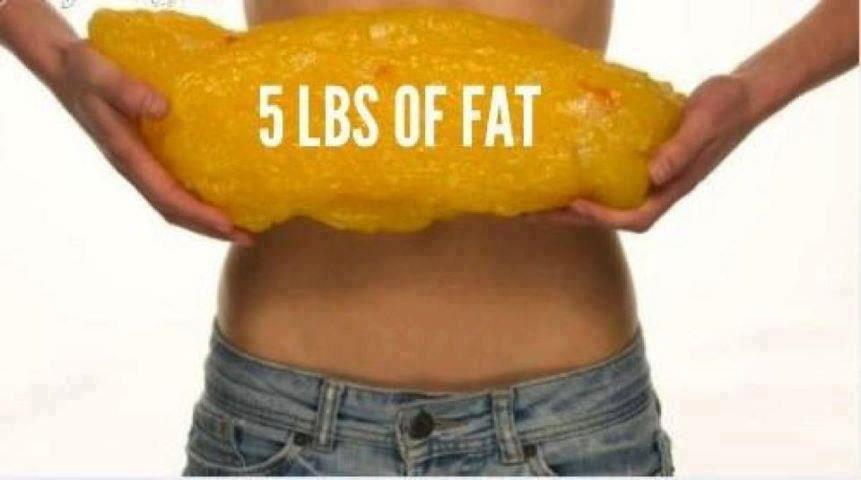Have you ever wondered what 10 pounds of fat actually look like? This thought might have crossed your mind while stepping on the scale or setting a fitness goal.
The answer might surprise you and could change the way you see your body and health forever. Imagine holding a soft, squishy mass the size of a large watermelon—almost unbelievable, right? But there’s more to it than just the size.
Understanding this can provide you with a clearer picture of your fitness journey. It’s not just about numbers; it’s about visualizing your progress and feeling empowered. Stick with us, and you’ll discover why knowing what 10 pounds of fat looks like is a game-changer for your health and motivation. Ready to see the bigger picture? Read on to find out more.
Understanding Body Fat
Understanding body fat is crucial for grasping how our bodies function. Fat is not just about appearance or weight. It’s a vital component with specific roles in our health. Knowing about body fat can help us make informed health decisions.
Types Of Body Fat
Body fat comes in different types, each with unique characteristics. The most common are subcutaneous and visceral fat. Subcutaneous fat lies under the skin. It’s the fat you can pinch. Visceral fat surrounds the organs. It’s deeper in the body and less visible.
Subcutaneous fat is usually harmless. It provides insulation and stores energy. Visceral fat, on the other hand, can be dangerous. It links to health issues like heart disease and diabetes.
Functions Of Fat In The Body
Fat plays many roles in the body beyond just storage. It insulates and protects vital organs. Fat also serves as an energy reserve. When your body needs extra energy, it breaks down fat.
Fats are important for absorbing vitamins. They help in absorbing vitamins A, D, E, and K. These are fat-soluble vitamins. Without fat, your body can’t use them effectively.
Hormones are another area where fat is crucial. Fat helps in hormone production. This includes hormones that regulate metabolism and mood.

Credit: www.reddit.com
The Science Behind 10 Pounds Of Fat
The journey to understanding what 10 pounds of fat looks like begins with science. While you might envision a small stack of butter or a bunch of bananas, the reality is more complex. This section breaks down the science into digestible parts, helping you visualize the unseen.
Volume And Density Of Fat
Fat takes up more space than muscle. Imagine a bag of cotton balls compared to a bag of marbles; both may weigh the same, but the cotton balls take up more room. Fat, like those cotton balls, is less dense.
One pound of fat is roughly the size of a small grapefruit. Multiply that by ten, and you have an image of what 10 pounds of fat might look like. It’s not just about the scale; it’s about the space it occupies in your body.
You might think losing a pound will drastically change your appearance, but the volume plays a significant role. Understanding this can help you manage expectations on your fitness journey.
Weight Vs. Appearance
Have you ever lost weight but felt your clothes fit the same? This is where weight versus appearance comes into play. Ten pounds of fat might not drastically change your appearance because fat is more about volume than weight.
Muscle is denser and takes up less space than fat. You can weigh more with a toned body and still appear slimmer. This is why focusing solely on the scale can be misleading.
Consider how your clothes fit or how toned you feel. These indicators can be more telling than the number on the scale. How do you measure success in your fitness journey?
Understanding the science of fat can empower you. It equips you with the knowledge to set realistic goals and appreciate the changes beyond just weight loss. How will this new understanding shape your perspective?
Visualizing 10 Pounds Of Fat
Imagining 10 pounds of fat can be shocking. It might resemble a large stack of butter or a small watermelon. This visual helps grasp the impact of weight loss or gain.
Visualizing 10 Pounds of Fat Have you ever wondered what 10 pounds of fat actually looks like? It’s more than just a number on the scale. Visualizing this amount can give you a fresh perspective on your health journey. Understanding the physical size of 10 pounds of fat might surprise you and motivate you to approach your goals with renewed energy.Comparisons To Everyday Objects
Imagine holding a large bag of potatoes. This is approximately the volume of 10 pounds of fat. Now, think about carrying this weight around all day. It gives you a tangible sense of the impact that shedding or gaining this weight can have on your body. Consider the space it takes up in your body. This isn’t just about weight; it’s about volume and how it affects your overall health and mobility.Photographic Representations
Pictures can be incredibly powerful. Seeing side-by-side images of 10 pounds of fat and muscle highlights the stark difference in density. Muscle is denser and takes up less space, which is why two people who weigh the same can look very different. Look at before-and-after photos of weight loss journeys. They often highlight not just the pounds lost, but the change in body composition, showcasing the volume of fat that has been eliminated. Visualizing 10 pounds of fat can be eye-opening. It helps you understand the real impact of your health choices. How does this change your perspective on your fitness goals?
Credit: www.reddit.com
Common Misconceptions
Many people imagine 10 pounds of fat as a large, bulky mass. Surprisingly, it resembles a compact, yellowish blob. It can be deceptive, as fat takes more space than muscle.
When you think about losing 10 pounds of fat, what comes to mind? Do you imagine a smaller waistline or a lighter number on the scale? There are many misconceptions about what losing 10 pounds of fat actually looks like. It’s not always about a dramatic change in appearance. Understanding these misconceptions can help you set realistic expectations and achieve your fitness goals more effectively.Spot Reduction Myth
One of the biggest misconceptions is the idea of spot reduction. Many people believe they can lose fat from specific areas by targeting them with exercises. Have you ever tried doing countless sit-ups in hopes of melting away belly fat? Unfortunately, that’s not how it works. Your body decides where to lose fat, not you. Doing exercises for a certain area can strengthen the muscles there, but it won’t necessarily burn the fat covering them. Instead, focus on overall fat loss through a combination of cardio, strength training, and healthy eating.Fat Versus Muscle Weight
Another common misconception is equating fat loss with overall weight loss. Muscle and fat weigh the same, but they take up different amounts of space. Ten pounds of fat is bulkier and takes up more room than ten pounds of muscle. When you lose fat and gain muscle, the scale might not show a big change. But your body composition and measurements can tell a different story. Have you ever noticed your clothes fitting better even if your weight hasn’t dropped much? That’s because muscle is denser than fat, leading to a leaner, more toned appearance. Understanding these differences can shift your focus from just losing pounds to improving overall body composition. Isn’t it more satisfying to feel stronger and healthier, rather than just lighter? Remember, the journey to fitness is personal and unique. What matters most is progress, not perfection. How will you redefine your goals with this new understanding?Impact On Health And Fitness
Visualizing 10 pounds of fat can help understand its impact on health and fitness. It resembles a large, squishy mass, similar to a bulky, fluffy pillow. Recognizing this can motivate better diet and exercise choices, promoting healthier living.
Understanding what 10 pounds of fat look like can be eye-opening, especially when considering its impact on your health and fitness. Many people don’t realize how extra weight can affect their daily life. It’s crucial to know how excess fat influences your body and what benefits you gain from maintaining healthy fat levels.Health Risks Of Excess Fat
Excess fat can lead to numerous health issues. It increases the risk of heart disease, diabetes, and certain cancers. It’s not just about the number on the scale; it’s about how fat affects your organs and overall well-being. Carrying extra weight can strain your joints and muscles. This can make daily activities more challenging. You might notice that climbing stairs or even walking short distances feels more taxing. Emotional health can also take a hit. Excess fat often impacts self-esteem and mood. It’s not uncommon to feel less confident, which might affect your social interactions and mental health.Benefits Of Healthy Fat Levels
Maintaining healthy fat levels supports overall health. It improves heart function, reduces the risk of chronic diseases, and promotes longevity. Your body functions more efficiently when it’s not burdened by excess weight. With balanced fat levels, you enjoy better mobility. Activities like jogging or playing sports become more enjoyable. You might even find yourself participating in new physical challenges that seemed daunting before. Improved mental well-being is another benefit. When you feel good about your body, your confidence grows. This often leads to a more active social life and a more positive outlook on daily challenges. Do you know how your current fat levels are affecting your health and fitness? Taking a moment to reflect on this can be the first step toward a healthier lifestyle. Making small, consistent changes can lead to significant improvements in your life.
Credit: m.facebook.com
Practical Steps To Manage Body Fat
Managing body fat is crucial for health. Excess fat affects well-being and confidence. Understanding fat’s appearance helps set realistic goals. Ten pounds of fat can surprise many. It’s bulky and can impact daily life. Taking practical steps is essential. Focus on diet and exercise for effective results.
Dietary Adjustments
Eating habits influence body fat. Choose whole foods over processed ones. Include fruits, vegetables, and lean proteins. Limit sugar and unhealthy fats. Portion control is key. Smaller portions prevent overeating. Drink water before meals. It reduces hunger, aiding portion control.
Plan meals ahead. Avoid unhealthy snacks. Prepare balanced meals at home. Cooking at home gives control over ingredients. Use spices for flavor, not fat. Read labels on packaged foods. Watch for hidden sugars and fats. Track your food intake. Stay aware of eating patterns.
Exercise And Lifestyle Changes
Physical activity reduces body fat. Aim for daily exercise. Even short walks help. Strength training builds muscle. More muscle burns more fat. Include cardio like running or cycling. It boosts metabolism.
Stay active throughout the day. Take stairs, not elevators. Stand while working or reading. Simple changes make a big impact. Sleep well each night. Rest affects metabolism and hunger. Manage stress effectively. Stress can lead to weight gain. Practice relaxation techniques.
Join active communities. Group activities motivate you. Set achievable exercise goals. Track your progress. Celebrate small victories. Stay committed to your lifestyle changes. Consistency brings results.
Frequently Asked Questions
How Big Is 10 Pounds Of Fat?
Ten pounds of fat can be quite significant. Visually, it resembles a large loaf of bread or roughly the size of a small watermelon. Fat takes up more space than muscle, making it appear bulkier.
What Does 10 Pounds Of Fat Weigh?
Ten pounds of fat weighs exactly ten pounds, just like any other substance. However, due to its low density, it appears larger than the same weight of muscle.
Can You Lose 10 Pounds Of Fat Quickly?
Losing 10 pounds of fat requires a calorie deficit over time. It’s best achieved through consistent diet and exercise. Rapid loss is not sustainable and can affect health negatively.
How Does Losing Fat Affect Body Shape?
Losing fat can slim the body, revealing muscle tone and contours. It improves overall appearance and can enhance health and fitness levels.
Conclusion
Ten pounds of fat can change your body’s look and feel. It’s more than just a number on the scale. Fat takes up space and affects your health. Understanding what 10 pounds of fat looks like helps set realistic goals.
It inspires better food choices and exercise habits. Seeing this impact can motivate healthy lifestyle changes. Remember, every small step counts in your fitness journey. Stay committed and patient. Results will follow. You have the power to shape your body and health.
Keep focused and positive. Your efforts will pay off in the long run.
{ “@context”: “https://schema.org”, “@type”: “FAQPage”, “mainEntity”: [ { “@type”: “Question”, “name”: “How big is 10 pounds of fat?”, “acceptedAnswer”: { “@type”: “Answer”, “text”: “Ten pounds of fat can be quite significant. Visually, it resembles a large loaf of bread or roughly the size of a small watermelon. Fat takes up more space than muscle, making it appear bulkier.” } } , { “@type”: “Question”, “name”: “What does 10 pounds of fat weigh?”, “acceptedAnswer”: { “@type”: “Answer”, “text”: “Ten pounds of fat weighs exactly ten pounds, just like any other substance. However, due to its low density, it appears larger than the same weight of muscle.” } } , { “@type”: “Question”, “name”: “Can you lose 10 pounds of fat quickly?”, “acceptedAnswer”: { “@type”: “Answer”, “text”: “Losing 10 pounds of fat requires a calorie deficit over time. It’s best achieved through consistent diet and exercise. Rapid loss is not sustainable and can affect health negatively.” } } , { “@type”: “Question”, “name”: “How does losing fat affect body shape?”, “acceptedAnswer”: { “@type”: “Answer”, “text”: “Losing fat can slim the body, revealing muscle tone and contours. It improves overall appearance and can enhance health and fitness levels.” } } ] }
